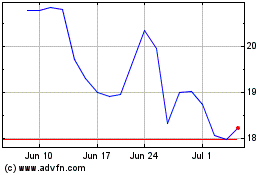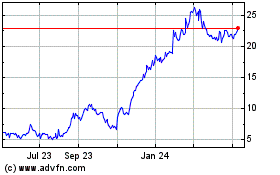Divesiran eliminated the need for phlebotomy in
all well-controlled patients following infrequent dosing and was
well tolerated
Data support advancing divesiran into Phase
2
Company to host conference call today at 8:30am
Eastern Time
Silence Therapeutics plc (“Silence” or the “Company”), (Nasdaq:
SLN), an experienced and innovative biotechnology company committed
to transforming people’s lives by silencing diseases through
precision engineered medicines, today announced positive results
from the ongoing SANRECO Phase 1 repeat dose study of divesiran
(SLN124), a siRNA (short interfering RNA) targeting TMPRSS6, in
patients with polycythemia vera (PV).
“With today’s very exciting PV data, Silence is continuing to
emerge as a true platform company. Both of our lead proprietary
programs are now generating excellent clinical results,” said Craig
Tooman, President and CEO at Silence. “Divesiran is poised to be
the first siRNA for PV, and we look forward to advancing
development with a phase 2 start planned by year-end.”
The 34-week, open-label Phase 1 study is evaluating divesiran (3
mg/kg, 6 mg/kg and 9 mg/kg) administered subcutaneously every 6
weeks for four doses, with a 16-week follow-up period following the
date of the last administered dose in up to 24 PV patients. Key
inclusion criteria include a PV diagnosis and a history of
requiring at least three phlebotomies in the last six months or
five in the last year prior to screening. Patients are allowed to
be on stable doses of cytoreductive agents. Given the exploratory
nature of this Phase 1 study, both well-controlled patients -
defined as those with hematocrit (HCT) levels at 45% or less – as
well as those with HCT levels greater than 45% at baseline on
current standard of care treatment were enrolled.
The data being presented today are based on a data cut-off date
of March 29, 2024, and include analysis of 16 patients over a time
range of approximately 4 to 34 weeks of study involvement. Of the
16 patients, 8 patients are considered well-controlled and 8
patients have HCT levels over 45% at baseline.
To date, divesiran has been observed to be well tolerated with
no major safety issues.
None of the 8 patients entering the trial with well-controlled
HCT levels required a phlebotomy during the divesiran treatment
period, which was defined in the study as the period up to 6 weeks
after the last dose. All patients in the well-controlled group
maintained adequate control of HCT levels as per treatment
guidelines. Of the 8 patients entering the trial with HCT levels
above 45%, 2 patients each required one phlebotomy. The baseline
HCTs of these 2 patients were 56% and 53%. None of the 6 other
patients in this group required a phlebotomy. Notably, none of the
13 patients entering the trial with HCT levels of 50% or below – 8
well-controlled patients and 5 patients with HCT levels of 46-50% -
have required a phlebotomy to date.
In all dose groups, there was a sustained reduction in
hematocrit during the treatment period and favorable effects on
indices of iron metabolism. Hepcidin levels increased and were
sustained within physiological levels in all dose groups,
demonstrating target engagement.
“Divesiran treatment in PV patients results in sustained
increases in hepcidin, reflecting crucial target engagement,” said
Professor Tomas Ganz, MD, PhD, Distinguished Professor of Medicine
and Pathology Department of Medicine, UCLA. “Divesiran exerts a
beneficial effect on hematological parameters and significantly
reduces phlebotomies. These exciting data suggest that divesiran
has the potential to produce clinically meaningful outcomes in this
patient population.”
“Based on these early results, divesiran appears to meaningfully
impact key hematological parameters in this rare myeloproliferative
neoplasm,” said Steven Romano, MD, Silence’s Head of Research and
Development. “We are particularly encouraged by the safety profile
and the potential for divesiran to be administered infrequently to
PV patients requiring pharmacological intervention to manage their
disease.”
As of today, Silence has enrolled 21 patients in the SANRECO
study and the Company anticipates closing enrollment at the end of
this month. Full results are expected to be presented at a
scientific meeting later this year. Divesiran has received FDA Fast
Track designation and FDA Orphan Drug Designation for PV.
Conference Call and Webcast Details
Management will host a conference call and webcast today, June
27, 2024, at 8:30 am ET to discuss results from the ongoing SANRECO
phase 1 study. To access the call, please register online at
https://register.vevent.com/register/BI33ea9b075fa841ea9597cc915562e79c.
Participants are requested to register at a minimum of 15 minutes
before the start of the call. A replay of the call will be
available two hours after the call and archived on the same web
page for six months.
A live webcast will also be available on the Investors section
of the Company’s website at www.silence-therapeutics.com. An
archived webcast will be available on the Company’s website
approximately two hours after the event.
About PV
PV is a rare, myeloproliferative neoplasm – a type of blood
cancer - characterized by the excessive production of red blood
cells, often resulting in elevated hematocrit levels. Elevated
hematocrit above 45-percent is associated with a four-times higher
rate of death from cardiovascular or thrombotic events. PV is
associated with a range of burdensome symptoms including fatigue,
cognitive disturbance and pruritis and additionally, longer term
can transform to myelofibrosis and Acute Myeloid Leukemia. The aim
of treatment is to maintain hematocrit less than 45%, a level that
is associated with a reduced incidence of thrombosis and
CV-associated death. The current standard of care includes repeated
phlebotomies to reduce hematocrit and/or cytoreductive agents to
reduce red blood cell production. There are currently no approved
therapies that specifically target red blood cells and
hematocrit.
About Divesiran
Divesiran is Silence’s wholly owned siRNA developed from its
proprietary mRNAi GOLD™ platform that “silences” TMPRSS6 expressed
almost exclusively in the liver. TMPRSS6 is a negative regulator of
hepcidin, the body's master regulator of iron metabolism including
its absorption, distribution, and storage. By silencing TMPRSS6 in
PV patients, divesiran aims to increase hepcidin production and
release by liver hepatocytes, leading to the restriction of iron to
the bone marrow and, thus, reducing the excessive production of red
blood cells, a process dependent on availability of iron.
About Silence Therapeutics
Silence Therapeutics is developing a new generation of medicines
by harnessing the body's natural mechanism of RNA interference, or
RNAi, to inhibit the expression of specific target genes thought to
play a role in the pathology of diseases with significant unmet
need. Silence's proprietary mRNAi GOLD™ platform can be used to
create siRNAs (short interfering RNAs) that precisely target and
silence disease-associated genes in the liver, which represents a
substantial opportunity. Silence's wholly owned product candidates
include zerlasiran designed to address the high and prevalent unmet
medical need in reducing cardiovascular risk in people born with
high levels of lipoprotein(a) and divesiran designed to address
hematological diseases, including polycythemia vera. Silence also
maintains ongoing research and development collaborations with
AstraZeneca and Hansoh Pharma, among others. For more information,
please visit https://www.silence-therapeutics.com/.
Forward-Looking Statements
This press release contains “forward-looking statements” within
the meaning of the Private Securities Litigation Reform Act of
1995. All statements in this press release other than statements of
historical facts are “forward-looking statements. These statements
may be identified by words such as “aims,” “anticipates,”
“believes,” “could,” “estimates,” “expects,” “forecasts,” “goal,”
“intends,” “may,” “plans,” “possible,” “potential,” “seeks,” “will”
and variations of these words or similar expressions that are
intended to identify forward-looking statements, although not all
forward-looking statements contain these words. Forward-looking
statements in this press release include, but are not limited to,
statements regarding: the Company’s clinical development activities
and timelines for divesiran including the expected timing for
reporting further data from the SANRECO trial; the timing and
future occurrence of other clinical and clinical activities
including proposed clinical trial enrollment and the Company’s
plans and timing to advance divesiran into Phase 2; expected
clinical benefits of divesiran and the potential to produce
clinically meaningful outcomes in PV patients; and the Company’s
plans to submit additional data from the SANRECO trial for
publication at a future conference. These forward-looking
statements are based on the Company’s expectations and assumptions
as of the date of this press release. Each of these forward-looking
statements involves risks and uncertainties that could cause the
Company’s clinical development programs, future results or
performance to differ materially from those expressed or implied by
the forward-looking statements. Many factors may cause differences
between current expectations and actual results, including:
preliminary or topline results are based on a preliminary analysis
of key efficacy and safety data; the potential that success in
preclinical testing and earlier clinical trials does not ensure
that later clinical trials will generate the same results or
otherwise provide adequate data to demonstrate the efficacy and
safety of a product candidate; the impacts of macroeconomic
conditions, including the conflict in Ukraine and the conflict
between Israel and Hamas, heightened inflation and uncertain credit
and financial markets, on the Company’s business, clinical trials
and financial position; unexpected safety or efficacy data observed
during preclinical studies or clinical trials; clinical trial site
activation or enrollment rates that are lower than expected; the
Company’s ability to realize the benefits of its collaborations and
license agreements; changes in expected or existing competition;
changes in the regulatory environment; the uncertainties and timing
of the regulatory approval process; and unexpected litigation or
other disputes. Other factors that may cause the Company’s actual
results to differ from those expressed or implied in the
forward-looking statements in this press release are identified in
the section titled "Risk Factors" in the Company’s Annual Report on
Form 20-F for the year ended December 31, 2023 filed with the U.S.
Securities and Exchange Commission (the “SEC”) on March 13, 2024 as
well as its other documents subsequently filed with or furnished to
the SEC. The Company expressly disclaims any obligation to update
any forward-looking statements contained herein, whether as a
result of any new information, future events, changed circumstances
or otherwise, except as otherwise required by law.
View source
version on businesswire.com: https://www.businesswire.com/news/home/20240627515407/en/
Silence Therapeutics plc Gem Hopkins, VP, IR and
Corporate Communications Tel: +1 (646) 637-3208
ir@silence-therapeutics.com Media Relations MKC
Strategies Mary Conway Tel: +1 (516) 606-6545
mconway@mkcstrategies.com
Silence Therapeutics (NASDAQ:SLN)
Historical Stock Chart
From Dec 2024 to Jan 2025

Silence Therapeutics (NASDAQ:SLN)
Historical Stock Chart
From Jan 2024 to Jan 2025
